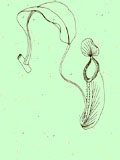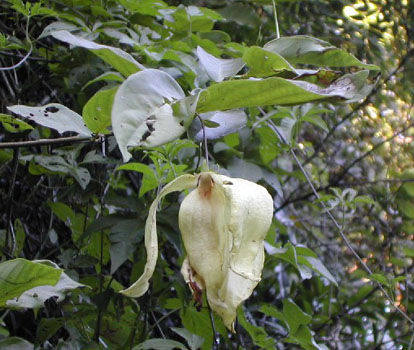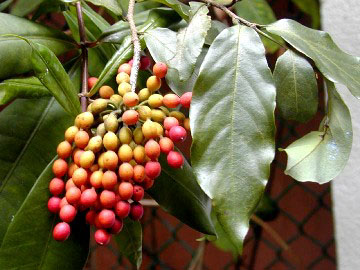

 |
Diversity At A Glance (pdf)
This column aims to introduce interesting species of Hong Kong flora and fauna that might be encountered during fieldwork. Distinctive physical characteristics and some interesting ecological facts are included for each example.
| Editors : | Jacqueline Weir (jesweir@hkusua.hku.hk) and |
| David Poon (dynpoon@graduate.hku.hk) |
|
|
|
|
|
"Desmos"
by Ada Ng
Desmos Lour. is a small genus in the pantropical plant family Annonaceae. This genus comprises about 25-30 species. They are either climbers or scandent shrubs that often have leaves that are glaucous below. Some species have edible fruits while some are commonly used as folk medicines in Asian countries.
One Desmos species, D. chinensis, is found in Hong Kong. It is a spreading shrub in shady places and may develop into a higher climber. This species is widespread in Asia and northern Australia. The plants are commonly found in thickets and hedges in Victoria Peak, Pokfulam Country Park, Tai Mo Shan, Tai Po Kau, Sai Kung, Lantau Island, Lamma Island etc. The flowers open between April and July and fruit can be observed from June to March of the following year.
Phenology
The solitary flower is pendent on a pedicel and often terminal or supra-axillary. Each flower consists of three sepals and six valvate petals in two whorls. The outer three petals are longer than the inner ones, with numerous stamens and carpels in the centre. Young flowers are green and inconspicuous. The outer petals open first followed by the inner ones, and then some time later the reproductive organs in the middle are exposed. The petals grow in length and breadth and with the colour gradually changing from green to light yellow. The lower part of each inner petal grows closer again and then coheres together, forming a pollination chamber between the petals, and allowing insects, like beetles, to enter it.
 |
|
Fig.
1. Mature flower of Desmos chinensis.
|
The flower is hermaphrodic and protogynous, and the stigmas become receptive before the pollen is released from the anthers. During the pistilate phase, bright red marks can be observed on the petals and at the same time, and strong fruity scent can be detected at a distance, especially during the evenings. It is observed that small beetles are attracted by the scent and they visit the flowers during this period. This stage can last for 24 hours or longer and is followed by pollen exposure. When the flower fades, the petals turn to rusty-red and then drop.
 |
|
Fig.
2. Mature fruit of D. chinensis.
|
The shape of the fruits makes them more easily recognisable than the flowers. From the end of the flower pedicel, a series of carpels radiates outwards like a chain of beads. The fruit are fleshy berries and each carpel contains one to several seeds with constrictions between each segment. They are green and inconspicuous at first and then change to yellow in autumn. They finally mature to red and later turn to brownish purple. It is observed that the ripe fruit is dispersed by birds. Check Desmos out as you go hiking in Hong Kong countryside!
|
|
P.14-15 |
|
Porcupine! |
 Copyright © 2000 |